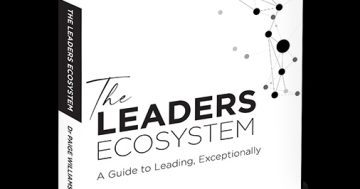
Leaders must see themselves as capable and deserving of their role, cultivating trust, respect, and recognition from those they lead. Photo: fellow.app.
Michelle Gibbings says just being good at what you do is not enough when you are promoted to a role where you have to manage people. She outlines how you can acquire this new set of skills to build a valid leadership identity.
Progressing up the organisational food chain usually requires you to move into a leadership position where you manage people.
The crunch comes when those technical skills that were initially critical become less important than leadership skills, and yet the required leadership skills don’t materialise.
It’s the classic case of the technical expert who struggles as a leader.
You might have faced this challenge at some stage in your career (I know I initially did) or have worked for a technical expert who isn’t a great leader.
Leaders can falter not because they lack technical know-how but because they haven’t fully understood or embraced their own leadership identity.
Leadership identity, as described by Daniel DeRue and Sue Ashford in their work Who will lead and who will follow?, is not simply a position or set of behaviours. It is a co-constructed relationship shaped by the mutual recognition between a leader and their team members.
When leaders claim their identity and followers grant it, a shared understanding emerges, reinforcing the leader’s legitimacy.
What’s crucial, therefore, is how leaders see themselves and how others perceive them. Leaders must first see themselves as capable and deserving of leadership roles. Concurrently, they must cultivate trust, respect, and recognition from those they lead.
The construction of your leadership identity is not static. It evolves throughout your leadership career.
One of my clients had been promoted to a more senior leadership position. However, when they first stepped into the elevated leadership role, they felt overwhelmed by the responsibility and the challenge of managing people who had once been peers. They also struggled to connect with the team and gain their trust.
Through work where they reflected on their values, strengths, and leadership style, they aligned their actions with a clearer sense of their own leadership identity.
By doing this, they improved team performance and gained the confidence to navigate challenges with authenticity and purpose.
Having a well-defined leadership identity helps on several fronts.
Firstly, it can help to guide your decision-making. Leadership often involves making high-stakes decisions under uncertain conditions.
A clear sense of identity anchors you, allowing you to act consistently with your values and long-term vision. This consistency builds trust and credibility within your team.
Secondly, in an uncertain and ambiguous world, you must navigate change with agility.
Having a secure leadership identity provides a foundation for flexibility so you can better adapt your approach without stepping away from your values or losing sight of who you are.
Thirdly, organisations look to their leaders for direction and purpose. A well-articulated leadership identity helps align teams around a shared mission, fostering cohesion and driving collective performance.
Understanding your leadership identity starts with introspection and feedback. Regularly reflect on your values, strengths, and aspirations.
For example, consider these critical questions: What drives you as a leader? What’s your leadership legacy and contribution? What are your core values and purpose?
Next, you’ll want to look for feedback from others. External perspectives are invaluable in shaping a realistic understanding of your leadership identity.
Tools such as 360-degree feedback or informal conversations with peers and team members can uncover blind spots and reinforce strengths.
You also want to consider the alignment with your role and operating context. As mentioned earlier, your leadership identity is not static. It must evolve to align with the demands of different roles and organisational cultures.
It helps to consider how your identity fits your current context and what adjustments are necessary.
Last, embark on a practice of trying and testing new ways of leading and then reflecting on outcomes. Your leadership identity emerges through practice.
By consciously claiming leadership roles and observing others’ responses, you can refine how you show up each day as a leader with your team and colleagues.
To claim your leadership position, you must undertake deliberate actions to reinforce and expand your leadership capacity.
While there is a range of focal points, the following are some crucial ones.
Embrace authenticity: This is the bedrock of a compelling leadership identity. Leaders who embrace their true selves, rather than conforming to stereotypes or external expectations, build deeper connections with their teams.
Invest in emotional intelligence: Emotional intelligence at work is critical for understanding both self and others.
Leaders with high EQ can navigate interpersonal dynamics effectively, ensuring that their claims to leadership resonate with those they lead. Practices such as mindfulness and empathy-building exercises will help elevate your EQ.
Practise continuous learning: The best leaders are perpetual learners. By staying curious and open to new ideas, leaders can adapt their identity to meet evolving challenges.
This might include formal education, mentorship, exposure to diverse perspectives and executive coaching. Take the time to build your personal learning plan.
Communicate a clear mission, vision and values: A strong leadership identity is rooted in a clear purpose and mission, compelling vision and lived values.
You want to know each of these and how they align with your role and your team’s needs.
Foster reciprocal relationships: Leadership identity thrives in a relational context.
You will want to actively seek feedback, acknowledge contributions, and build trust with your team and colleagues. Involving others in the co-construction of your identity strengthens your legitimacy.
So, the key question for today is: Do you know what your leadership identity is, and what steps do you need to take to craft and nurture it?
Michelle Gibbings is a Melbourne-based workplace expert and an award-winning author. She’s on a mission to help leaders, teams and organisations create successful workplaces – where people thrive, and progress is accelerated. She can be contacted at [email protected].











